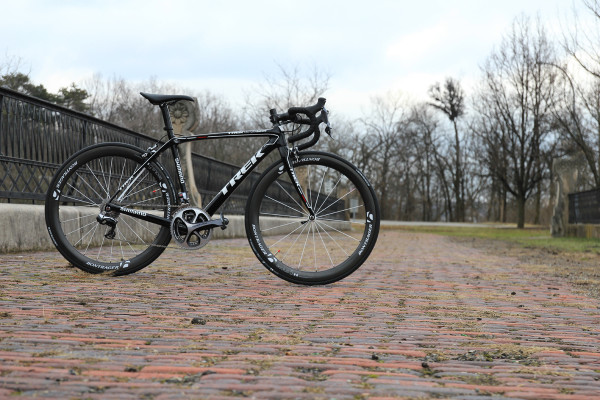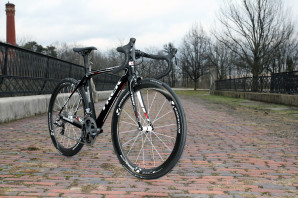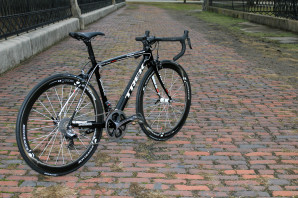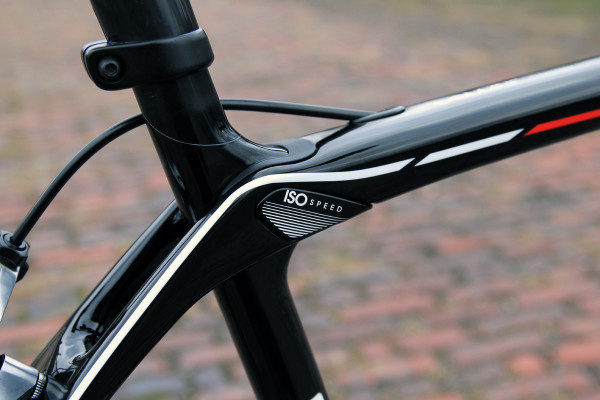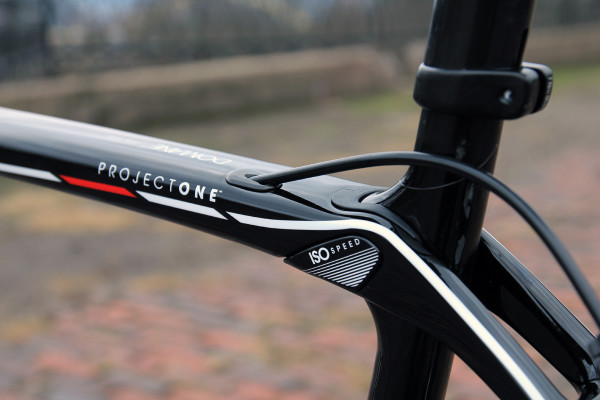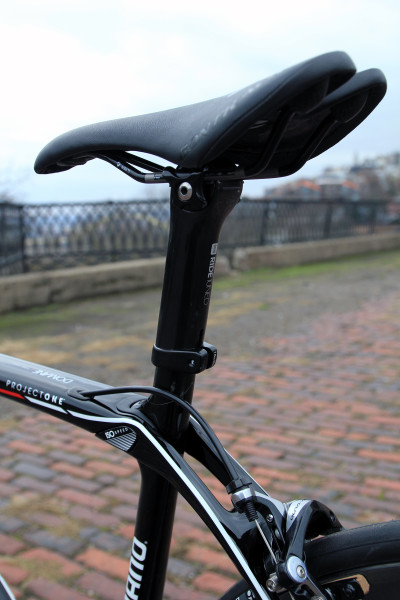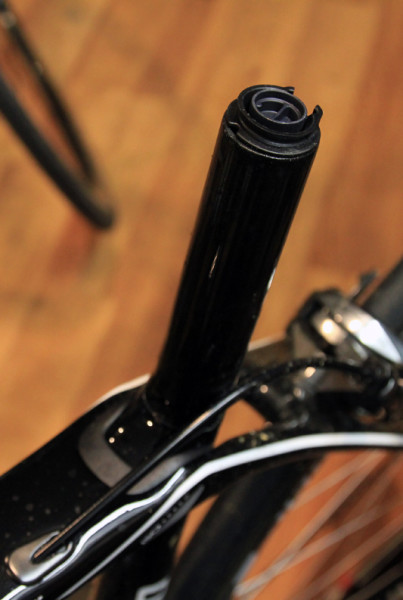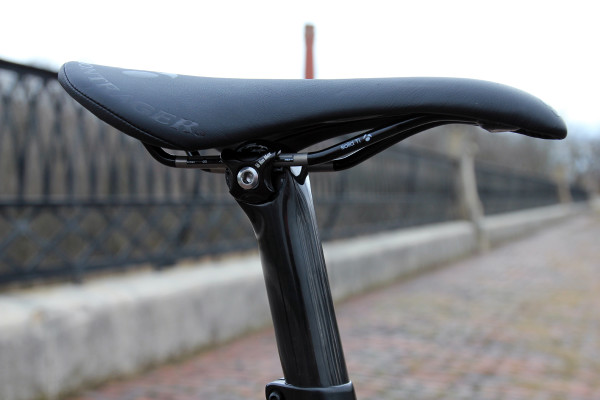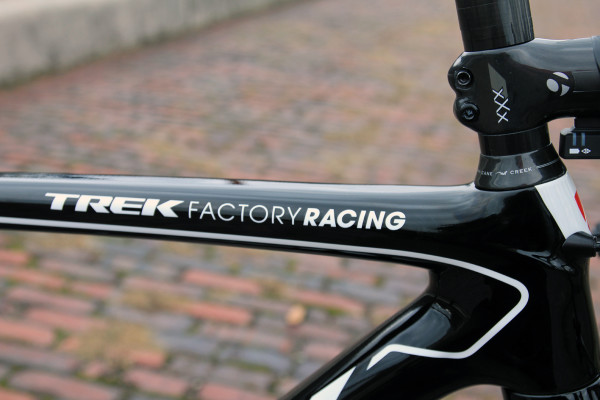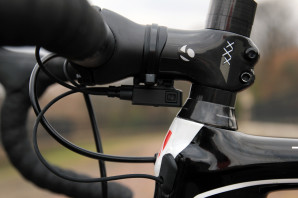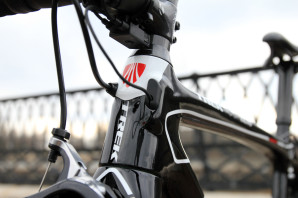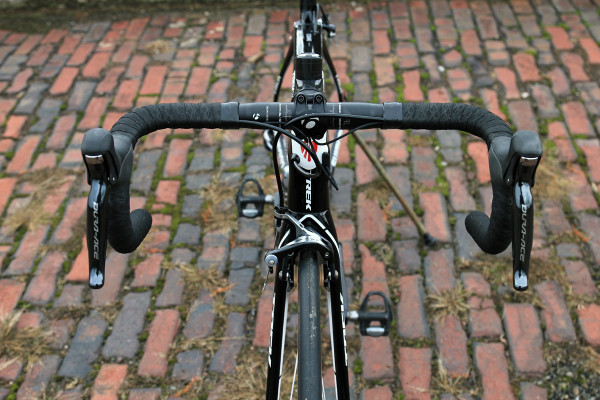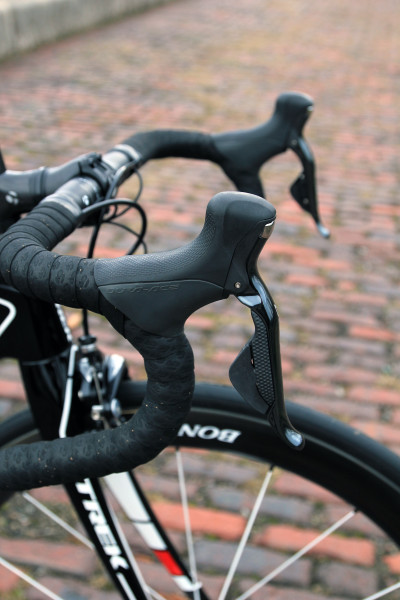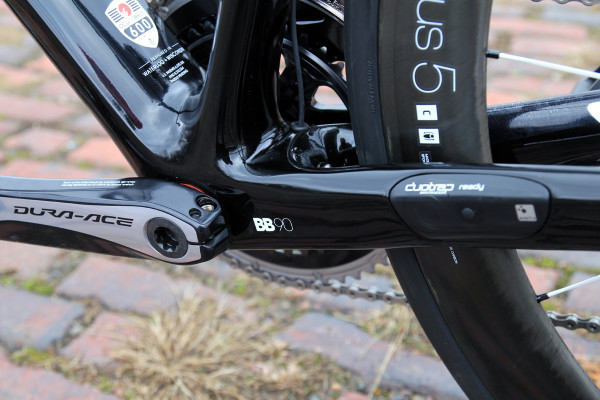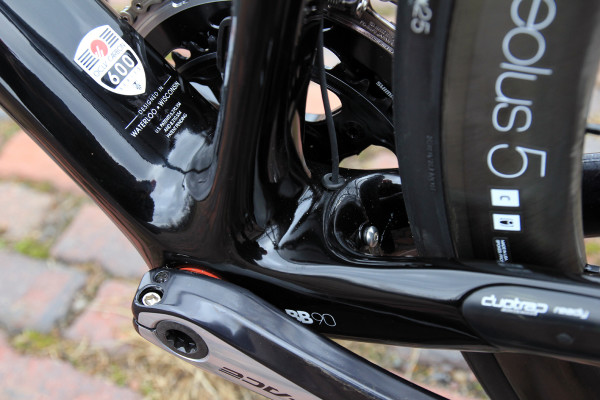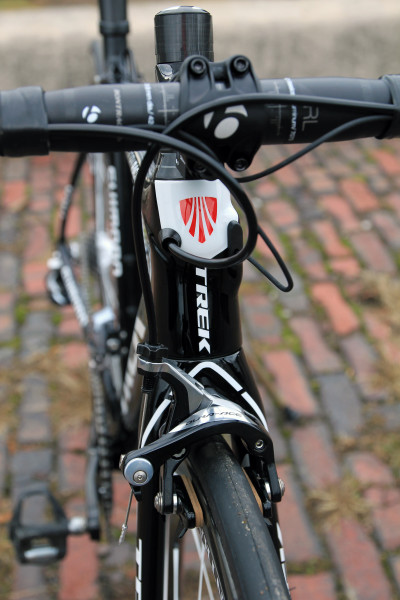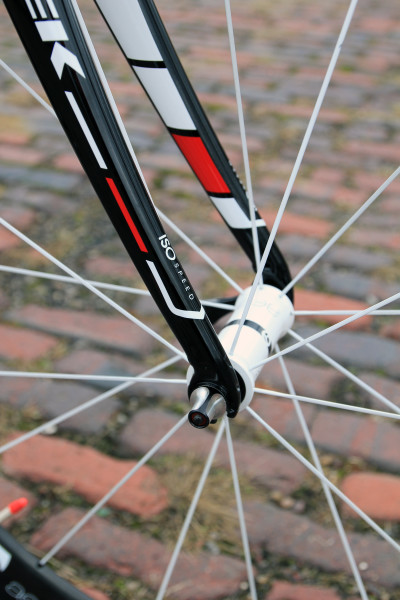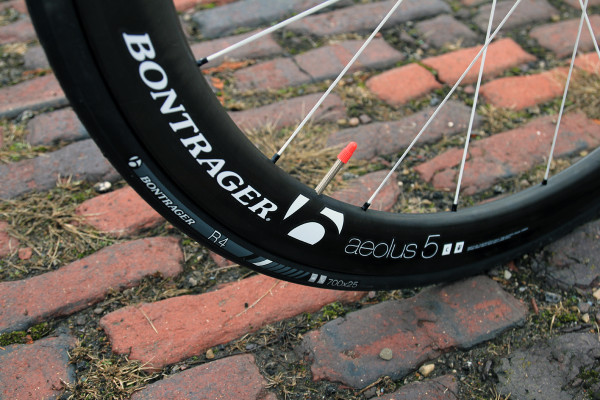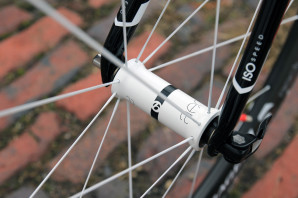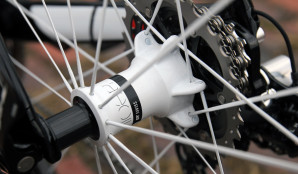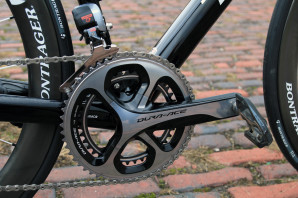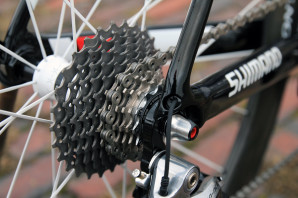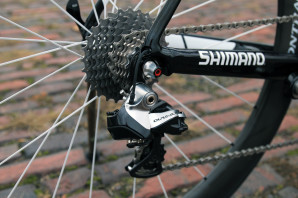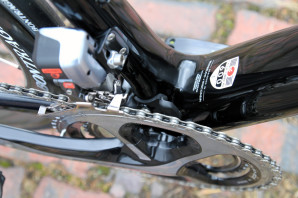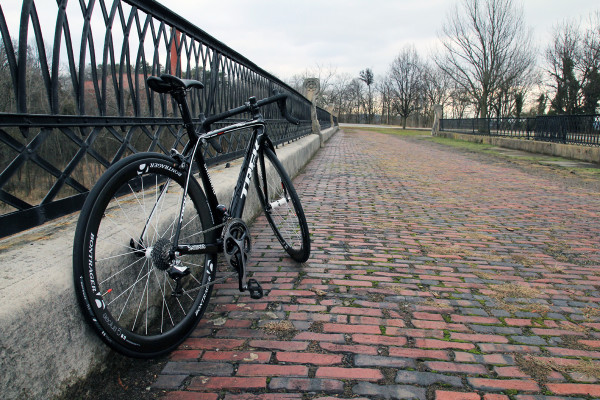Bring on the cobbles. Just after introducing the new Trek Factory Racing team on Friday, a special delivery showed up at our door step. One that was painted in Trek Factory Racing colors, and happens to be the very same frame that Trek’s pro racers use for Spring Classics and other rides where comfort and the ability to power over rough terrain is key. Of course I’m referring to the 2014 Trek Factory Racing Classics edition of the Trek Domane – the bike that introduced the IsoSpeed decoupler. Substantially limiting the amount of chatter felt by the rider at the saddle, IsoSpeed works well enough that they recently added to their latest cyclocross bike which certainly didn’t hold Sven Nys back on his way to yet another Belgian National Cyclocross championship.
On the road side, the Domane Classics edition was ridden to victory by Cancellara at the 2013 Paris-Roubaix. While the Classics edition won’t give you the legs of Spartacus, it will give you cobble eating performance with what was formerly a pro only fit.
Smooth is fast. You’ve heard the saying before, which the Domane Classics edition seems to exemplify. Compared to the standard Domane 6 series, the Classics edition loses 5.7 cm of head tube length (in size 54cm, tested), as well as going from a 71.3° to 72.6° head tube angle. Not only does this allow for a much lower, aggressive riding position, but thanks to 0.7 cm less of trail, the handling is quickened slightly as well. Other geometry tweaks include a slightly effective longer top tube (55 cm vs 54.2 cm), a slightly shorter wheelbase (100.4 cm vs 101 cm), and a lower standover thanks to the more horizontal top tube.
When it comes to sizing, Trek says since this is literally the frame the pros are riding, that means pro-only sizing as well. That means you won’t find a 44, 47, 50, or 52 cm frame in the line up, only the sizes the team uses – 54, 56, 58, 60, and 62 cm all made from 600 series OCLV carbon fiber right here in the US.
As the secret sauce of the Domane, the IsoSpeed decoupler is the same that you find on the standard Domanes. Underneath that IsoSpeed cap, you’ll find essentially a suspension pivot that holds the seat tube to the top tube. Without the axle in place, the seat tube is not actually attached to the top tube which allows it to flex around the axle which is what provides actual vertical compliance. Check out the video Tyler made of the IsoSpeed decoupler in action – you can actually see it flex.
Built with fully internal cable routing, the rear brake cable pops out of the top tube just in front of the IsoSpeed decoupler.
Like most of Trek’s high end road and now cross bikes, the Domane Classics edition uses their Ride Tuned seat mast cap which conceals the seat post battery for the Di2 system underneath. The neat part about how the battery is mounted is that since it is the frame, instead of the cap, you can remove the saddle and mast cap without having to disconnect the battery cable. Since the Dura Ace Di2 9070 group is charged through the junction box, there is no need to ever remove the battery and it stays sheltered from the elements.
The single bolt saddle clamp holds fast without a huge amount of torque unlike some early designs, and has clamp ears available for oval railed saddles and the cap itself is available in 5mm or 20mm setback options.
Short stems (90mm) plus short head tubes with stem mounted Di2 junction boxes equals interference if you’re trying to get low. Any lower on the stem and you’d have to figure out a way to push the junction box forward or mount it somewhere else. Our test bike was fitted with an aluminum Bontrager RL Classic bend bar, and Race XXX lite carbon stem.
At the crank, Trek’s BB90 bottom bracket is nearly flush with the down tube and allows for some massive chainstays while still keeping ample tire clearance. The Classics edition retains the Bontrager Duotrap compatibility which builds in ANT+ compatible speed and cadence sensors right into the chainstay.
While the Classics frame retains the lower mount for the rear fender, the hidden fender mounts at the dropout are gone. Since the fork is the same as the one used on the standard Domane 6 series, the hidden fender mounts are still there at the front.
That fork is the full carbon IsoSpeed with an E2 asymmetric steerer tube.That steerer combined with the slightly rearward curving droputs allow the fork to flex for and aft, yet remain stiff laterally for precise cornering.
The pros might ride the cobbles on tubulars, but consumers will likely roll on clinchers like the Aeolus 5 D3 clinchers equipped here. Just like the frame, the 50mm deep carbon clinchers are made in the USA from OCLV carbon. Designed with a wide, aero rim profile, the wheels have a 27mm external and 17.5mm internal width that rounds out the 25mm R4 tires well. Like many of the Bontrager wheels we’ve seen lately, the hubs use DT star ratchet internals with a stacked lacing design on the rear drive side, and 18/24 DT straight pull bladed spokes with Alpina locking nipples.
The drivetrain, like the rest of the bike, is top shelf. Shimano’s Dura Ace 9070 Di2 electronic drivetrain offers precise shifts in just about any condition – perfect for a bike like this. Gearing is offered in a standard 53/39 crank and 11-25 11 speed cassette. If you’re wanting the pro frame without the pro gearing, don’t forget that since this is offered through Trek’s Project One, all of the components are customizable to fit your needs. Priced at $11,519.99 (with a Bontrager Race X Lite IsoZone carbon bar), the Classics edition is certainly not cheap. However, if you’re wanting the frame’s geometry and not the high end build, it is possible to get the price below $5,000 with downgraded componentry on Project One.
One other critical frame detail that sets the Classics edition apart from the standard Domane? The rear derailleur hanger is not replaceable. Instead, it is an extra thick, built in hanger designed to keep the shifts as crisp as possible in the worst conditions. The frame retains the S2 chain catcher of the original Domane to keep your chain on the ring when you’re powering through rough patches.
Just a hair over 15 pounds, 15.08 lbs to be exact, there are lighter bikes on the market. But keep in mind that this is a race bike and still has to adhere to the UCI minimum weight requirement. So with a pair of tubulars instead of the D3 clinchers here, and a carbon bar instead of the Bontrager RL Classics aluminum bar, the bike is probably right at the minimum without having to add any ballast.
First Impressions:
Smooth. But that should come as no surprise as the Domane’s proven design has won over a lot of fans recently and the IsoSpeed technology hasn’t changed with the Classics Edition. For anyone that hasn’t ridden a Domane yet, it really does work as advertised. Maybe more so.
What has changed though is the geometry – while the comfort is the same, the Classics edition is built to go fast. Built with a steeper head tube angle and much shorter head tube, the Classics offers a faster ride with the ability to get low. Feeling like a cushy Madone, the Domane Classics does not like to go slow. Push back into the saddle, pull on the hoods, and give it all the power you have and it seems to reward you. With Spring just around the corner, I’ll be doing some classics riding of my own to find out just how unlike Cancellara I really am.
